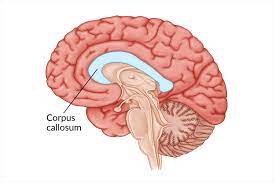
The corpus callosum is a wide commissure, a flat bundle of commissural fibers, about 10 cm long beneath the cerebral cortex.
It connects the left and right cerebral hemispheres, and enables communication between the hemispheres.
It is the largest white matter structure in the human brain, consisting of 200–250 million axonal projections.
The corpus callosum is the curved band of tissue at the center of the brain above the hypothalamus.
Its lighter texture is due to higher myelin content.
The myelin content accounts for fast neuronal impulse transmission.
The posterior end of the corpus callosum is called the splenium.
The selenium is the thickest part of the corpus callosum and overlaps the tela choroidea of the third ventricle and the midbrain, and ends in a thick, convex, free border.
The anterior end of the corpus callosum, near to the frontal lobes is called the genu.
The genu of the corpus callosum bends downward and backward in front of the septum pellucidum.
It bends backward under the name of the rostrum, and is connected below with the lamina terminalis, which stretches from the interventricular foramina to the recess at the base of the optic stalk.
The rostrum resembles a bird’s beak.
A narrowed part between the body and the splenium is known as the isthmus of the corpus callosum.
On either side of the corpus callosum, the fibers radiate in the white matter and pass to the various parts of the cerebral cortex; those curving forward from the genu into the frontal lobe constitute the forceps anterior, and those curving backward into the occipital lobe, the forceps posterior.
Its main body of the fibers constitute the tapetum and extend laterally on either side into the temporal lobe, and cover in the central part of the lateral ventricle.
The tapetum and anterior commissure have the function of connecting left and right temporal lobes.
The genu’s thinner axons connect the prefrontal cortex between the two halves of the brain.
Thicker axons in the mid body, or trunk of the corpus callosum, interconnect areas of the motor cortex
The splenium, the posterior body of the corpus, communicates somatosensory information between the two halves of the parietal lobe and the visual cortex at the occipital lobe.
There is a positive correlation between age and callosal thickness.
Sex differences are confined to certain parts of the corpus callosum, and that they correlated with cognitive performance in certain tests.
The midsagittal corpus callosum cross-sectional area is, after controlling for brain size, on average, may be proportionately larger in females.
The front portion of the human corpus callosum has been reported to be significantly larger in musicians than nonmusicians, and larger in left-handed and ambidextrous people than right-handed people.
Corpus callosum size correlates positively with verbal memory capacity and semantic coding test performance, and children with dyslexia tend to have smaller and less-developed corpus callosums than their nondyslexic counterparts.
Musical training increases plasticity of the corpus callosum during a sensitive period of time in development.
The implications are an increased coordination of hands, differences in white matter structure, and amplification of plasticity in motor and auditory scaffolding which would serve to aid in future musical training.
Children who have begun musical training before the age of six have an increased volume of their corpus callosum.
A corpus callostomy can reduce the symptoms of refractory epilepsy.
A corpus callosotomy is a palliative procedure for specially severe cases of epilepsy.
To prevent the spreading of seizures from one brain hemisphere to the other the corpus callosum can be split.
This procedure is mostly carried out on patients with so-called drop attacks that come with a very high risk of injury and in which the epileptic focus is not clearly delimitable.
It is very rare that a corpus callosotomy causes seizure freedom.
In half of the patients the dangerous drop attacks are less severe.
After a corpus callosotomy among others there is the risk that language is temporarily or permanently impaired.
The younger a patient is at the time of the corpus callosotomy, the better the prognosis.
Agenesis of the corpus callosum (ACC) is a rare congenital disorder that is one of the most common brain malformations.
Agenesis of the corpus callosum the corpus callosum is partially or completely absent, and is usually diagnosed within the first two years of life, and may manifest as a severe syndrome in infancy or childhood, as a milder condition in young adults, or as an asymptomatic incidental finding.
Hypogenesis, dysgenesis, and hypoplasia can occur as well.
There is a possible correlations between corpus callosum malformation and autism spectrum disorders.
Anterior corpus callosum lesions may be associated with akinetic mutism or anomic aphasia.
No gender difference is found in the size of the corpus callosum.
